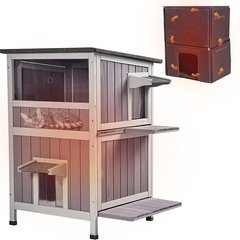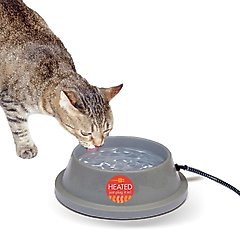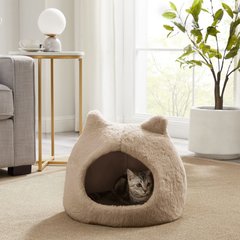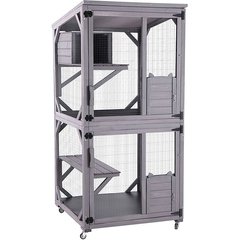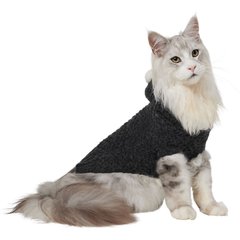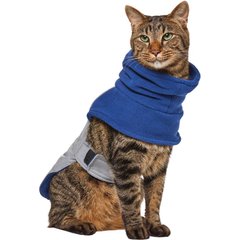How Cold Is Too Cold for Cats?

Photo by ThomasMorkeberg/ iStock/Getty Images Plus
Cats look well-adapted to the cold, but their lush fur and self-confident attitude hide an often-overlooked truth: They’re extremely vulnerable to cold. In fact, your cat may be uncomfortably chilly even in your climate-controlled home.
Understanding how cold is too cold for cats is important—not just for keeping them safe outdoors but also for promoting their well-being when they’re in our homes.
Key Takeaways
- Even when indoors, cats can feel chilly at temperatures that are comfortable for us.
- Outdoor temperatures below 45 degrees Fahrenheit are dangerous for cats.
- Prolonged exposure to temperatures below 32 degrees Fahrenheit can lead to frostbite and hypothermia in cats.
- Signs that your cat is cold include seeking warm spots; curling up tightly; and in extreme cases shivering, which may lessen as hypothermia sets in.
Do Cats Get Cold?
Yes, cats can get cold. In fact, even indoor-only cats spend much of their lives in settings that are uncomfortably cool for them. A concept called the thermoneutral zone (TNZ) helps to explain why.
A person’s or animal’s TNZ is the temperature range in which they don’t have to expend much extra energy to warm up or cool down.
For people (and conveniently for dogs too), that range is thought to be around 68 to 86 degrees Fahrenheit. Notice how most of us set our thermostats in that range? However, the TNZ for cats is much higher: 86 to 100 degrees Fahrenheit. So, when you’re comfortable in your home, your cat is probably cold.
How Cold Is Too Cold for Cats?
The problem gets even worse when you think about cats who live or spend time outside. Summer is surely their favorite season (even though it can still get dangerously hot for them), but when temperatures fall below 45 degrees Fahrenheit, cats can start to struggle. They’re at high risk of hypothermia and frostbite when they spend extended amounts of time in temperatures below 32 degrees Fahrenheit.
These are just generalities, however. Multiple factors will influence what temperature is too cold for cats:
- Age and health status: Kittens, senior cats, and those with health conditions are more vulnerable to cold because they can have difficulty regulating their body temperature.
- Coat type and color: Long-haired breeds like Maine Coons and Persians can handle colder temperatures better than short-haired, and particularly hairless, cats. Dark hair also absorbs more heat than light hair.
- Body condition: Overweight cats may have some insulation from fat, but underweight cats lose body heat quickly.
- Acclimatization: Outdoor cats who gradually adjust to seasonal temperature changes can handle cold better than indoor cats suddenly exposed to chilly weather.
- Activity level: Exercise generates body heat, so a cat who is out for a walk on a leash will probably be warmer than a cat who is lying under a bush when it’s cool outside.
- Other environmental conditions: Temperature isn’t the only weather factor that matters; dampness, wind chill, and cloud cover all play a role too.
How Can I Tell That My Cat Is Cold?
Recognizing when your cat is cold helps you take action to keep them comfortable and safe. Watch for these behavioral and physical signs that your cat may be cold:
- Seeking out warm spots like sunny windows, heating vents, or your lap
- Curling up in a tight ball to conserve body heat
- Hiding under blankets or in enclosed spaces
Further, if you notice any of these signs of hypothermia or frostbite, bring your cat to a veterinarian immediately:
- Shivering, which can lessen as hypothermia progresses
- Cold, pale, or blue-tinged ears, paws, or tail tip
- Slow, shallow breathing
- Stiff movements
- Weakness and lethargy
Can Cats Survive in the Cold?
Cats can survive the cold, but prolonged exposure to low temperatures poses serious health risks.
Keeping cats indoors is the best way to keep them safe and healthy regardless of how cold it is, but it becomes especially important when temperatures drop below 45 degrees Fahrenheit—and vital when it’s below freezing.
For outdoor cats (barn cats or community cats, for example), winter survival depends on access to warm shelter, food, and water. Community cats often seek refuge in garages, sheds, under porches, or in other protected areas. They can adapt to colder temperatures (by growing thicker fur, for example), but they still face significant challenges during cold snaps.
To help outdoor cats in your area, consider providing insulated cat houses, fresh water (in a heated bowl or replaced frequently as it freezes), and high-calorie food (kitten food is often a good option) to help them through the winter months.
Recommended Products
How To Keep Your Cat Warm in Winter
Several strategies can help ensure your cat stays comfortable when temperatures drop:
- Provide warm, draft-free sleeping areas. Sunny spots are ideal.
- Use heated cat houses or covered cat beds.
Recommended Product
Consider heating a small part of your home to a higher temperature for your cat’s comfort. A cat door can help keep the heat in while letting your cat come and go as they wish.
Recommended Product
- Brush your cat regularly to keep their coat in good condition.
- Limit outdoor time during extremely cold weather. This includes time spent in a catio or cat stroller
Recommended Products
Provide an indoor sweater for cats with thin or no hair. Consider a cat coat during brief outdoor excursions.
Recommended Products
- Keep your cat dry. Wet fur loses its insulating properties.
- Monitor kittens, older cats, and cats with health conditions more closely.
FAQs About How Cold Is Too Cold for Cats
Can cats get cold? How cold can cats handle?
Yes, cats get cold easily. They may be chilly when temperatures drop below 86 degrees Fahrenheit, and anything under 45 degrees Fahrenheit (and certainly below 32 degrees Fahrenheit) can lead to hypothermia and frostbite.
How do stray cats survive winter?
Stray cats survive winter by finding shelter in protected areas, growing thicker coats, and conserving energy. However, many struggle with frostbite, hypothermia, and finding adequate food and water.
Can cats stay in a cold garage?
Cats can stay in a cold garage temporarily if they have warm bedding or a heated cat house. However, unheated garages aren’t ideal for extended periods.
Can cats handle cold better than dogs?
No, most cats prefer warmer temperatures in comparison to dogs, although factors such as coat type, age, and health also come into play.

